by John Clayson
We've gathered together stories and photographs which illustrate life down the years at Grantham Yard signal box. There are reports from the local newspaper The Grantham Journal (which continues in publication today) and we’ve searched far and wide for photographs. Most importantly, people who worked on the railway at Grantham have kindly shared their personal recollections of the job and of the people they worked with.
We are presenting what we have in chronological order. Material is still coming to light and we will slot new items in as they are discovered. If you have anything which adds to the story of the Yard Box at Grantham please let us know.
Storm Damage - 10th August 1891
A lightning strike during a violent summer thunderstorm damaged a signal post near the Yard Box.
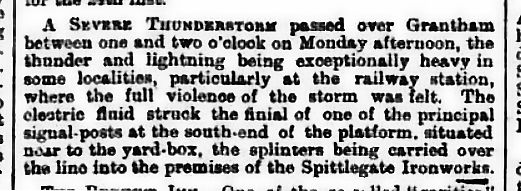
From The British Newspaper Archive
Image © THE BRITISH LIBRARY BOARD. ALL RIGHTS RESERVED.
"Hold on! Where are you going to?" - a collision, 7th July 1898
At 12.44am a Manchester to London passenger, mail and perishables train stopped as scheduled in the Up Main line platform at Grantham station. A few minutes later it started off for the south past the Yard Box. Almost immediately it collided, nearly head-on, with a goods locomotive which was bringing wagons out of the goods yard across the Up Main line at the south end of the passenger station. The accident occurred at at low speed and there was no derailment, but nine persons were slightly injured. Both of the locomotives and several items of rolling stock were damaged.
The site of the collision is shown on this map:
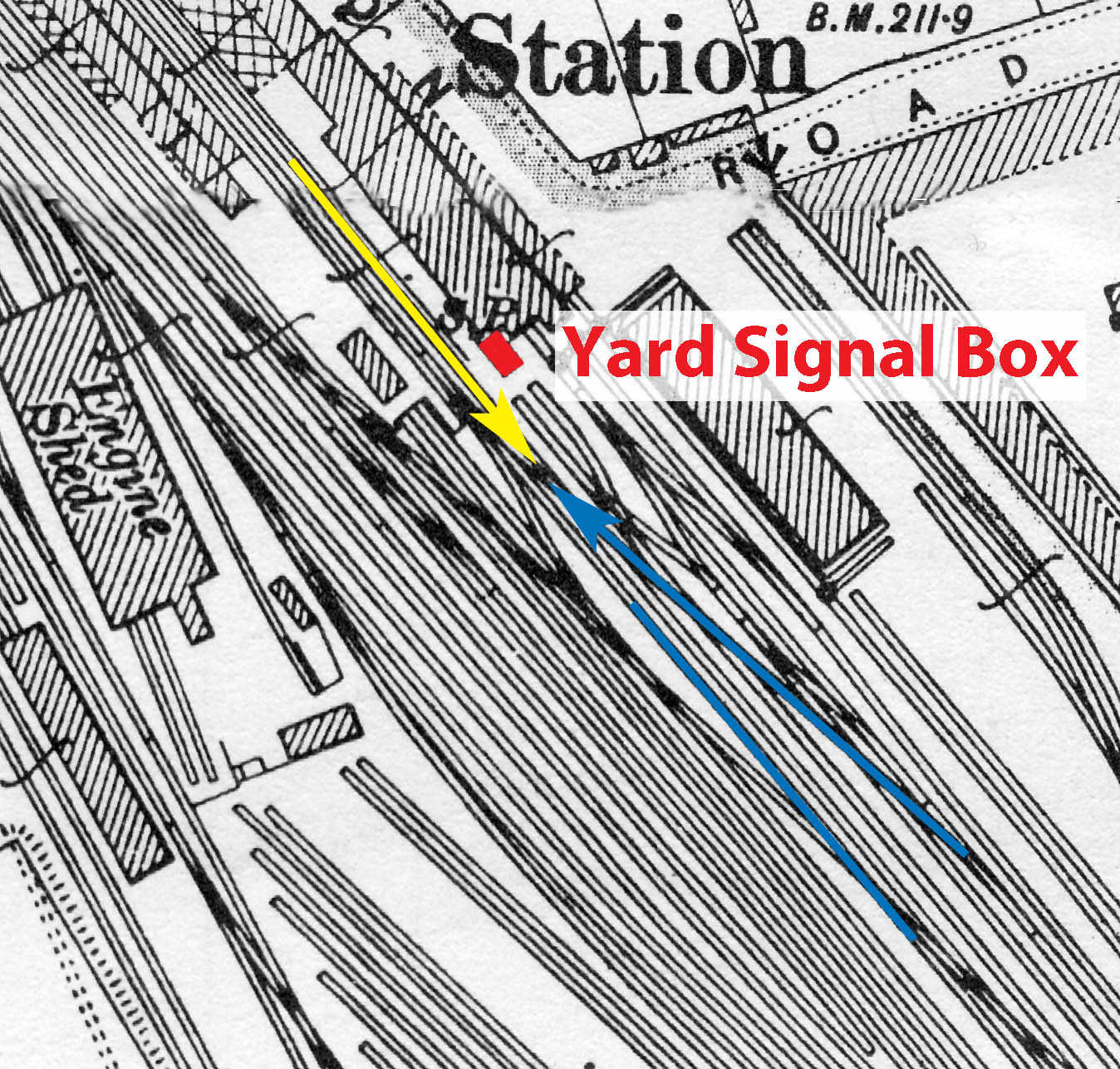
At work in the Yard Box was experienced signalman James Herring. His signals for the Manchester train were at danger while he was setting the road for the goods locomotive to move forward out of the siding. When he heard the locomotive of the Manchester train whistle and saw it begin to get under way he showed a red lamp and shouted "Hold on! Where are you going to?" to the crew as they passed his box.
The Board of Trade enquiry heard that the driver of the Manchester train had been oiling his locomotive on the side away from the platform when his fireman received the guard's signal to start. The fireman informed his driver, who gave the fireman permission to get under way as he climbed up onto the footplate. However, neither of the men had checked the starting signal at the end of the platform. They saw signalman Herring's red lamp and heard his shouted warning, but it was too late to avoid the collision.
Here is a link to the Board of Trade accident report.
At the time of the accident James Herring of St Ann Street, Grantham had been a signalman at Grantham for more than 31 years. He was still in post in 1901. The lamp he used in his vain attempt to prevent the collision could well be the one ilustrated below.

Below is a memo issued to the Yard Box signalmen in 1921 by Station Master William Bradley reminding them to clean and trim their hand lamps according to the GNR's instructions.


The High Speed Mail Train Derailment - 19th September 1906
This was the night of the dreadful accident at the north end of the station described in the equivalent page relating to Grantham North box. A northbound overnight mail train which was scheduled to stop at the station ran through at high speed and was disastrously derailed at the junction just beyond Grantham North.
Signalman Isaac Crowson was on duty at the Yard Box and was called as a witness to the enquiry. His view of the approaching train was partly obscured by a southbound train which was standing near to the Yard Box, but he observed that:
When the train passed my box I thought it was going at a terrible rate - I should say 50 miles an hour. I at once gave the 'train on line' signal, but by that time the engine was past me.
and
The speed of the train appeared to me to be nearly the same as that of a train which was running through without stopping at Grantham.
Isaac Crowson had been a signalman on the Great Northern Railway for 31 years, with nearly 22 years at Grantham Yard Box.
Clean & Tidy!
The following two memos were delivered to the Yard Box in 1914 and 1936.
The first is very specifically addressed to the three shift signalmen individually, indicating that Stationmaster Essame intended it as a personal reprimand, effectively a 'written warning', to the men concerned.

The names of the three Signalmen being admonished by the Stationmaster appear elsewhere on our website:
- Isaac Crowson had been the man on duty in the Yard Box at the time of the 1906 disaster, and he gave evidence at the enquiry;
- by 1931 Ernest Lancaster had achieved promotion to the North Box, from where in 1933 he was again promoted to Inspector (he must have got the hang of using duster, floor polish and Brasso!)
- William Sheffield is listed as a signalman at the South Box in 1939.
Below is a much more general message - a complaint about conditions at 'certain signal boxes' (un-named) which was issued to all boxes. It's a reminder to 'declutter' the space beneath the working floor of the box which housed the mechanical interlocking mechanism for points and signals. This was an essential safety feature which was required by law to be maintained in sound operational condition.

Rates of Pay, 1912

Someone being paid 29/- (29 shillings) each week would be thought of as doing quite well. The job would have around same status as one paying £845 per week today (or an annual salary of £43k), which is towards the top end of the basic salary range for signallers on Network Rail in 2019.
Telegraph Lads, 1912

Telegraph Lads were trainees who provided assistance to signalmen while learning the job. At some signal boxes they were on duty only on certain shifts, when traffic was heavy. It appears that in 1912 the line was becoming busier on Sunday nights.
Fogmen, 1920
Fogmen were nominated railway employees, often platelayers or gangers, who assisted with signalling in poor visibility. They would be called out by signalmen when they were unable to see a certain feature, known as the 'fogging point', which was a predetermined distance from their box. Part of the fogman's role was to stand at a signal and place a detonator (a small explosive device) on the rail when the signal was at danger as an additional, audible, warning to drivers. A hut, similar to a military sentry box, was provided for the fogman's shelter.

Photograph taken by Noel Ingram.
Two Retirements - spring 1930
Joseph William Smith and Walter Piggott, two signalmen who commenced work on the railway in the 1880s, retired from the railway service at the Yard Box in March and April 1930.
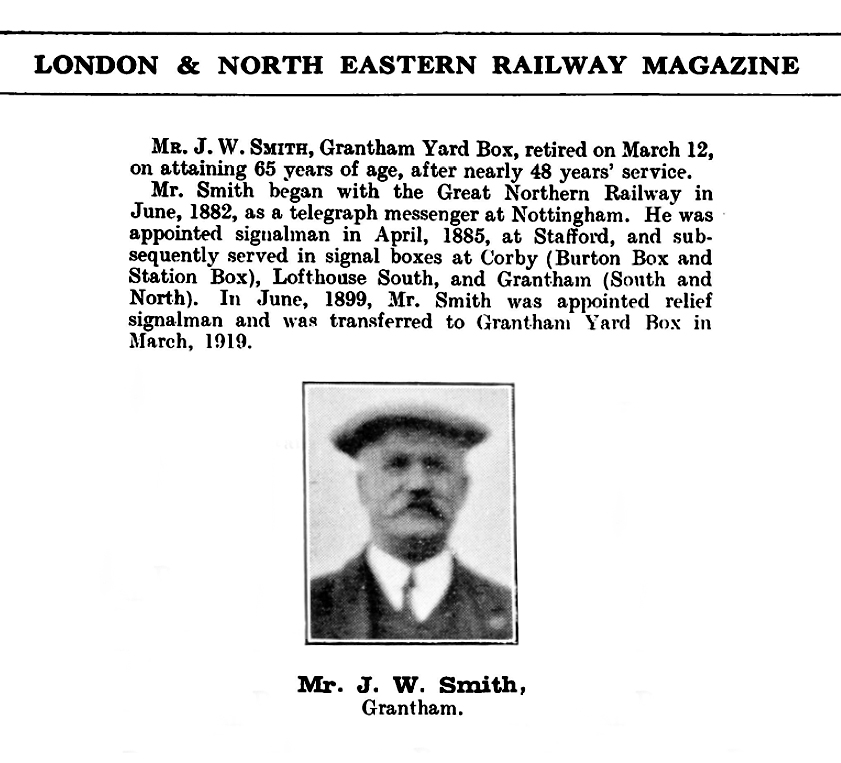
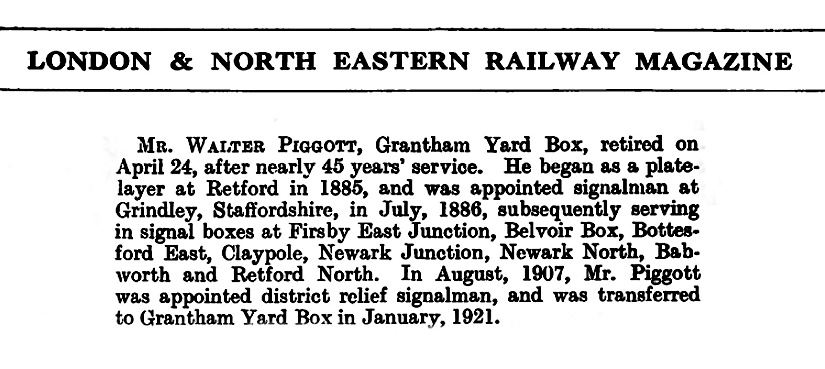
__________________________________________________________
Grantham Yard Box Signalmen, October 1939
In October 1939 a ‘Return of Staff’ was compiled for Grantham Passenger Station. It lists employees by name with their job and place of work, dates of birth, their date of entry to the railway service and their rate of pay.
Here are the men who were working at Grantham Yard signal box:
Signalmen:
Thomas Stephen Carter
♦ born 4/9/1882; entered service 2/1906; paid £3 5s per week
Arthur Gilbert
♦ born 6/9/1885; entered service 28/3/1900; paid £3 5s per week
Albert Taylor
♦ born 10/2/1892; entered service 1907; paid £3 5s per week
Relief Signalmen:
Henry Charles Swallow
♦ born 6/6/1890; entered service 27/10/1913; paid £3 10s per week
Bertie Sidney Brassley
♦ born 7/8/1897; entered service 17/10/1892; paid £3 10s per week
Telegraph Lads
Kenneth James Holdsworth
♦ born 6/4/1920; entered service 1/4/1935; paid £1 15s per week
Roland Harris
♦ born 2/2/1921; entered service 30/1/1939; paid £1 10s per week
One Vacancy
The signalmen at the Yard Box were paid £3 5s per week. By comparison, a signalman’s pay at Grantham North Box was £3 15s, at Grantham South Box £3 10s, and at Barrowby Road £2 15s.
The information above was kindly submitted by correspondent Strang Steel to the Returning to Grantham thread on the LNER Forum here (commencing on page 70).
_____________________________________________________________
Staff at Grantham Yard Box 1959-1962
Former Grantham signalling staff have helped to compile a list of the signalmen who worked the Yard Box:
Regular Shift Signalmen
♦ Albert Lawton (Mick Grummitt, Telegraph Lad, worked with Albert ocasionally)
♦ Joe Drage
♦ Johnny Parnham
♦ Joe Booth
Rest Day Relief
♦ Albert Steptoe
__________________________________________________________
1963 and 1964
Early in 1963 Grantham station and associated buildings were given a fresh coat of paint. The dark green of the steam age was replaced by lighter colours which could be expected to remain clean as steam locomotives were phased out.
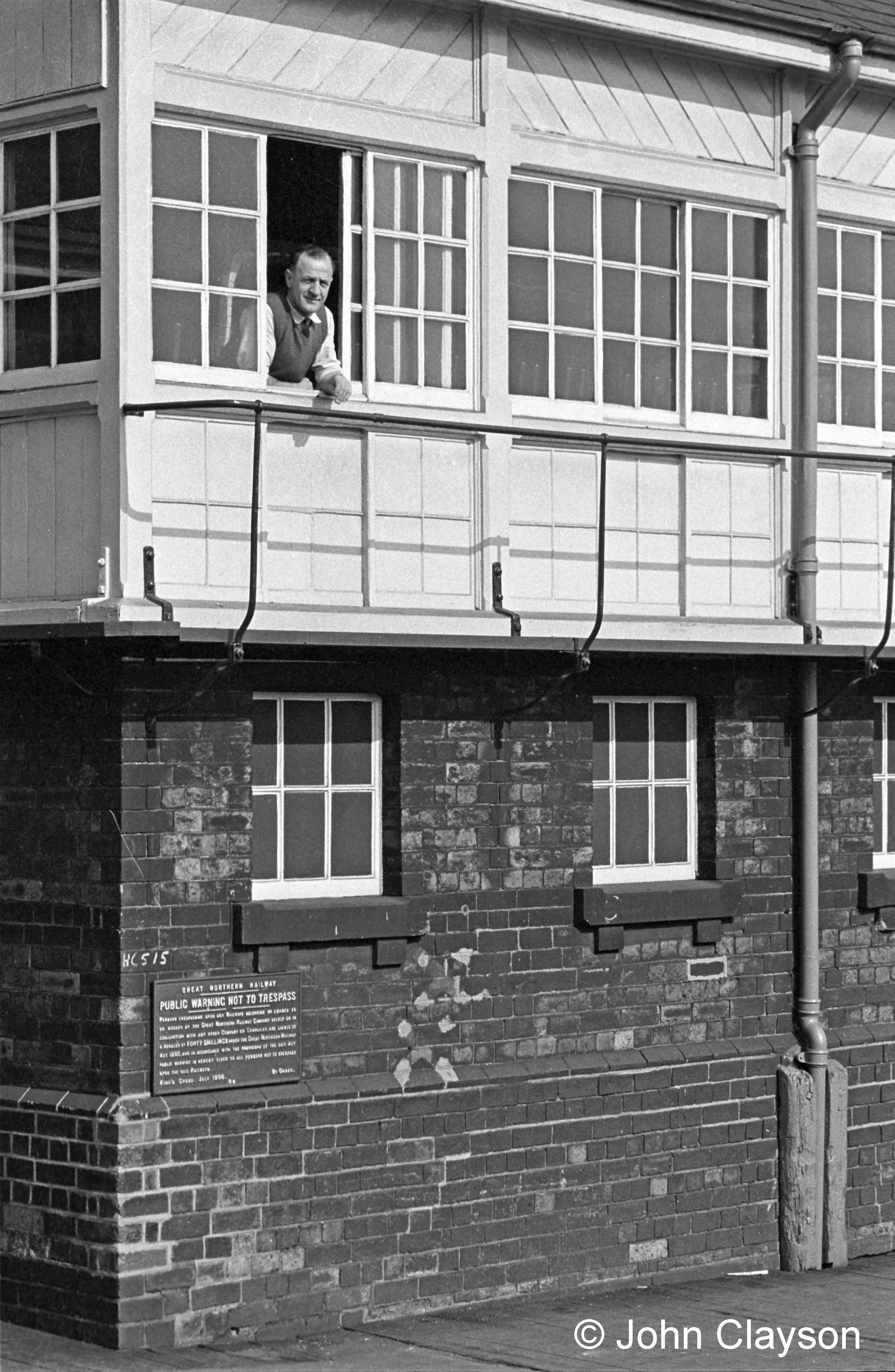
Photograph by Cedric A. Clayson.
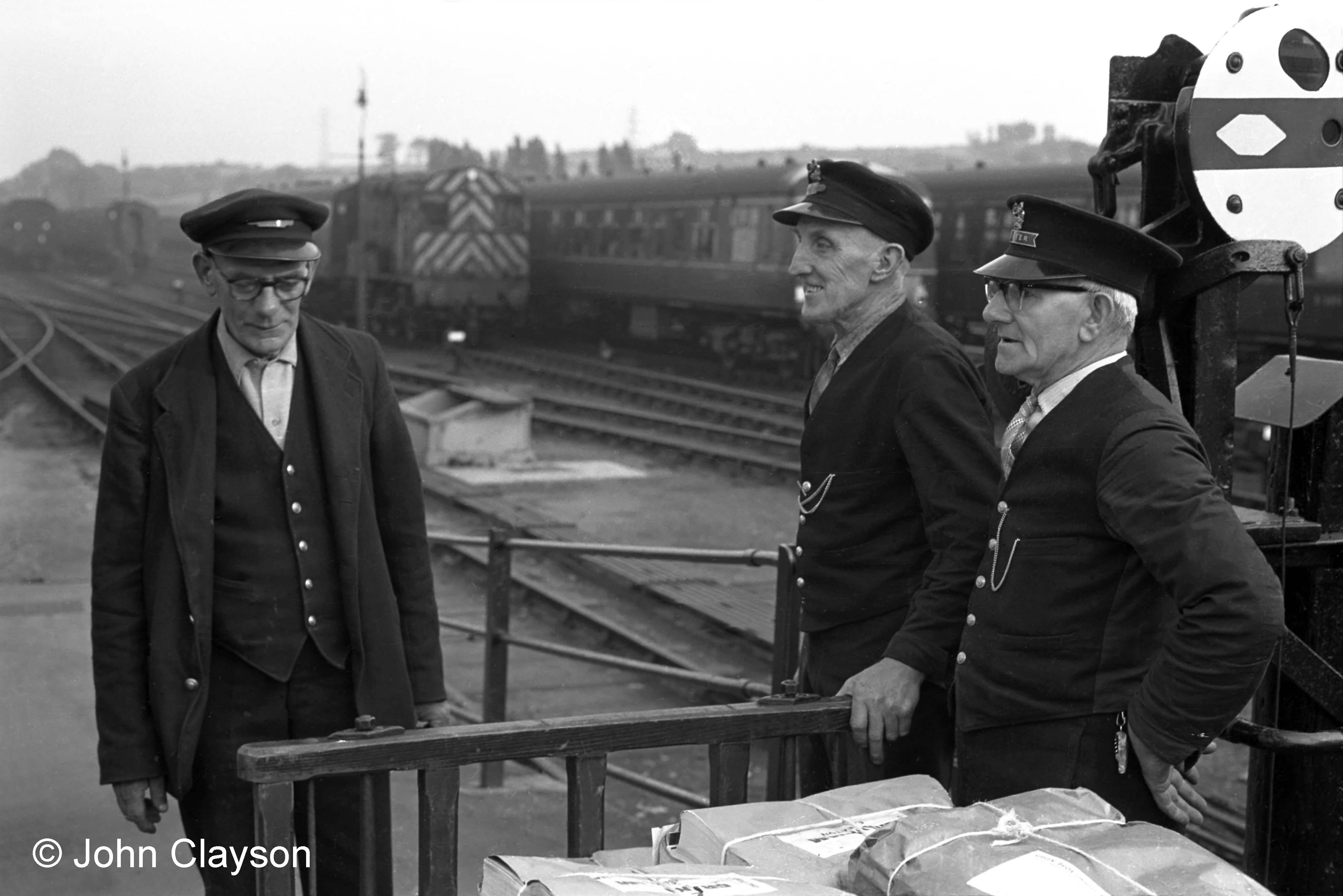
The porters are, left to right, Alf Woodward, Mr White and Bob Carpenter.
Photograph taken on 27th June 1963 by Cedric A. Clayson.
Inside theYard Box
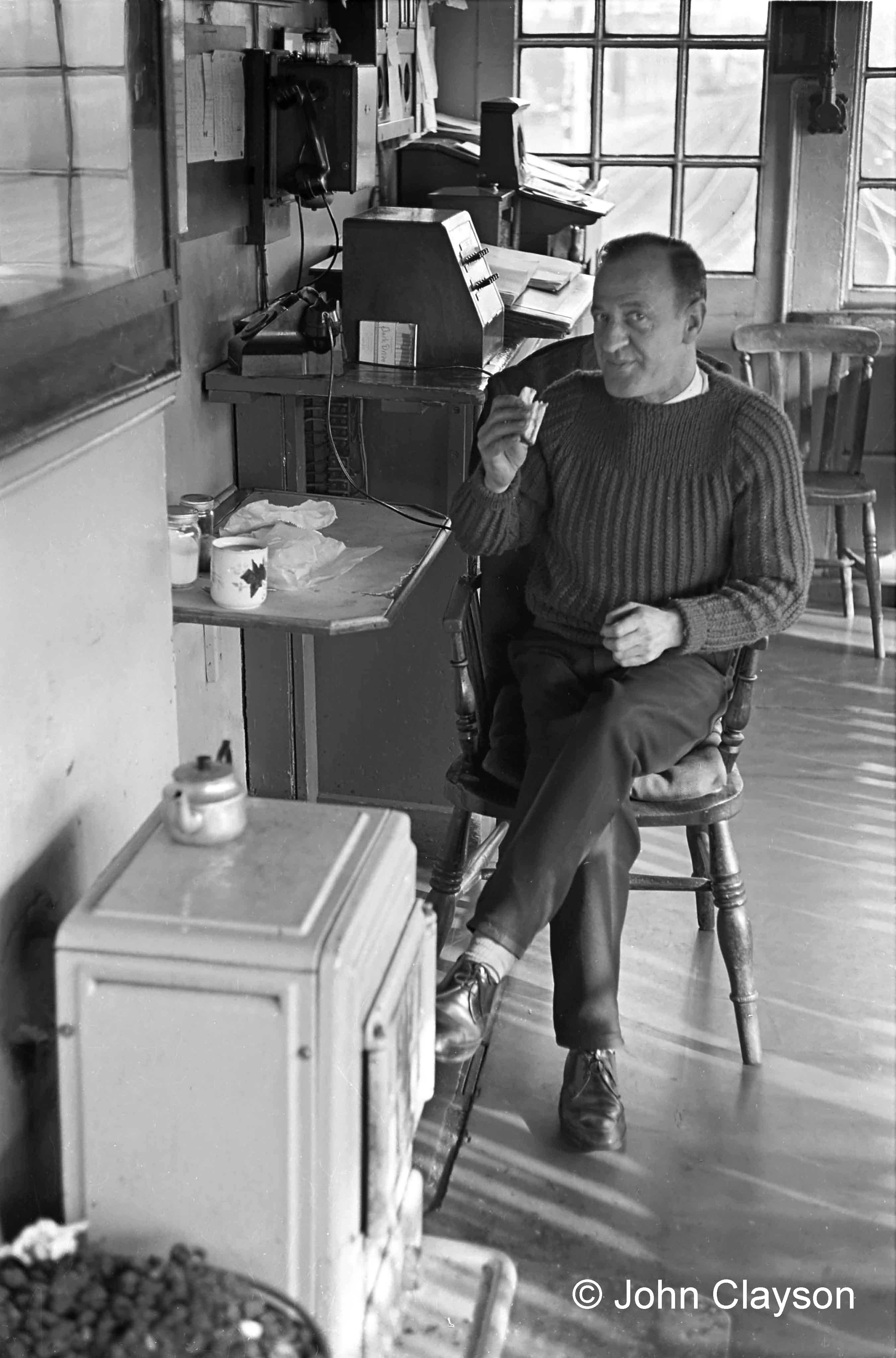
Photograph taken on 16th April 1964 by Cedric A. Clayson.
Some features visible in the photograph above
In the foreground is a coke-burning stove. Beyond the signalman is a wall-mounted telephone for voice communication with other signal boxes, with drivers calling from telephones at signals, with the station announcer and, most importantly, with ‘Control’. Control was the nerve centre of an area of the railway, from where the whole business of operating the line was managed and co-ordinated. Messages about late running trains, breakdowns and other occurrences were passed to, and received from, Control.
The box with the angled front on the desk below the telephone is a telephone concentrator. Bob Balchin explained how it worked at the Return to Grantham project meeting on 14th May 2014:
It normally had one handset. There were switches you see on the front, along with an indication lamp associated with each switch. The switches allowed the signaller to connect to incoming calls if the respective switch was placed in one position, and make outgoing calls if it was in another. This arrangement allowed for most telephone lines to be concentrated on one piece of equipment instead of having numerous telephone instruments.
Beyond the telephone is the sloping-topped train register desk. All activity in the signal box was logged carefully in the train register - an essential record in the event of an incident.
Further on, with a sloping support for a notepad, is a single-needle 'speaking' telegraph instrument. This system was an earlier means of communication than the telephone between the signal boxes in the immediate area. For example, it enabled signalmen to monitor the progress of express trains so that decisions could be made locally on holding freight trains in loops or sidings. The ‘ting tong’ of its needle was sometimes quite continuous because every message on the circuit was relayed to each instrument (an 'omnibus' system), although each signal box had its unique call sign.
Ray Phillips, an EWS driver in 2008 who started his railway career as a Telegraph Lad at Grantham, told me that in his day the circuit from Retford to Grantham used the single-needle telegraph, but from Grantham southward to Peterborough the telephone was in use. He recalled that the call signs were as follows: Grantham North: AB; Yard Box: GJ; South Box: GX, and Stoke SK.
There is comprehensive information about this system of communication here, from which the following is copied [July 2009]:
…these single-needle instruments survived in intensive use right into the early 1970s. They were popular with signalmen as there was no need to pick a phone up to take a message, and indeed it was possible to hear messages intended for others and get a picture of how trains were running. With this information, signalmen were able to regulate traffic accurately without any need for Control intervention.
Back to the Grantham Yard Signal Box index page
Copyright note: the article above is published with the appropriate permissions. For information about copyright of the content of Tracks through Grantham please read our Copyright page.


